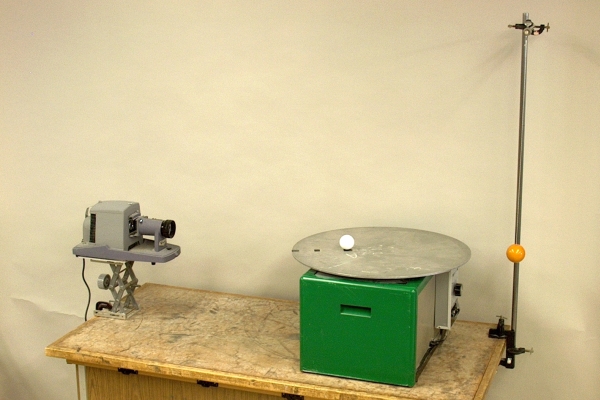
Turn on the projector. Then turn on the turntable, on the “LO” setting. (This setting is the first click of the switch. This is important! The frequency of oscillation of the mass-spring is about 36 cycles per minute, or about 0.60 Hz, which corresponds to a setting of about 68 on the dial. This should be set before class, and should not be changed.) Now pull the yellow ball to the side, so that its shadow overlaps that of the orbiting styrofoam ball when it is at the point in its motion closest to that side. At the appropriate time (just as the styrofoam ball is at this turning point), release the yellow ball. The two shadows should then overlap as the pendulum oscillates and the styrofoam ball goes around its circle.
When an object travels in a circle at constant speed, if we take the center of the circle as the origin of a pair of coordinate axes, then the x and y coordinates of the object both vary sinusoidally. Thus, the projection of the object’s motion along either axis (or any line parallel to a tangent of the circle) is a sinusoidal variation of position along a straight line. If we illuminate the object in a direction that is parallel to the plane in which it moves, then the moving shadow cast by the object is such a projection, and its position varies sinusoidally. We can then set a linear oscillator parallel to the tangent of the circle that is perpendicular to the direction of the illumination, and line it up so that the range over which its shadow travels corresponds to that for the object moving in a circle. If we adjust the period of the object’s circular motion to correspond with the period of oscillation of the linear oscillator, and then set the linear oscillator in motion at the proper time, the shadows of the object moving in a circle, and of the linear oscillator overlap. For small angles of displacement, the motion of a pendulum is essentially linear, and its position varies very nearly sinusoidally. Its motion is thus similar to the linear projection of the motion of the orbiting styrofoam ball, and we can make the projected shadows of the moving ping-pong ball and oscillating yellow ball overlap.
This demonstration provides a good way to illustrate the concept of phase for a linear sinusoidal oscillator. One complete cycle of motion of the mass-spring corresponds to one complete orbit of the ping-pong ball, or an angular displacement of 2π radians or 360 degrees. One half cycle is then π radians or 180 degrees, one quarter cycle is π/2 radians or 90 degrees, etc. (See also demonstration 40.03 -- Circular vs. mass-spring motion.)